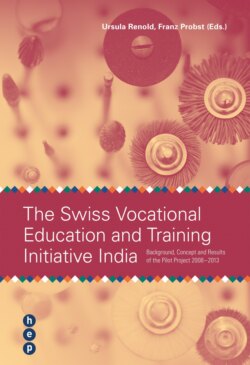Читать книгу The Swiss Vocational Education and Trainig Initiative India - Ursula Renold - Страница 16
На сайте Литреса книга снята с продажи.
2.1 Transition pathways between compulsory school and upper-secondary II education
ОглавлениеAfter completing compulsory school education, students continue with upper-secondary II education (see Figure 2). At this level, the young people have the choice between two main pathways: vocational education and training or general education. Various measures have been put in place to ensure the smooth transition between compulsory education and upper-secondary II education.
One such measure is the provision of numerous independent career information centres (CIC) that support the students in their search for and decision-making process regarding an appropriate education programme, taking into account their interests and abilities. The centres provide unbiased information about all possible educational programmes and can also be consulted for career decisions later in life (SDBB/CSFO 2008).
After visiting the CIC, students are encouraged to get a deeper insight into the desired fields of study or occupations, whether by attending information sessions, taking short «sniffing courses» or pre-apprenticeships (from one or two days up to a week) in companies. In this way, students can compare the expectations they have of the occupation or course with the reality in order to make an informed decision. However, this is only the first step towards their dream job. The second step involves being accepted in the chosen education programme or company.
The possible entry barriers for general education are the students’ grades or an entrance examination, depending on the canton. In VET, students need to find an apprenticeship position at a company in the desired occupation. The search for an apprenticeship position and the application process on the apprenticeship market is designed along similar lines to job searching in the labour market (SBFI 2014, p. 11). This means that students have to find an open apprenticeship position and apply by sending a letter of application. From the received applications, the companies invite suitable candidates for an interview. Thereafter, the companies are free to choose which candidates they want to hire as apprentices.
In addition, there is an early support programme, the Case Management System, for students who are at greater risk of dropping out of the education system at this level, or are at risk of not finding an education opportunity. This programme was launched in cooperation with the federal and the cantonal authorities in 2006, with the aim of better coordinating the existing support measures of various institutions so as to offer the students a customised solution[5].
Despite the support measures in place, some students do not find a suitable education opportunity after their compulsory education. Possible reasons are indecision concerning the future course of studies, failure to find an apprenticeship position in the desired area or company, failing the entry exam or obtaining insufficient grades to continue studying in one of the general education programmes. Regardless of the reason, the state offers bridge options to overcome the intermediate year. Students are encouraged to undertake a tenth school year, look for a pre-apprenticeship, take part in a preparatory course, or go abroad for an exchange semester to learn a foreign language.
The purpose of all these measures is to prevent students from dropping out of the education system without a post-compulsory qualification. Furthermore, these measures are intended to increase the students’ satisfaction with regard to their choice and keep the drop-out rate as low as possible. Statistics show that these measures are working, as around 95 per cent of students complete post-compulsory education (SBFI 2015a, p. 14).
The courses at upper-secondary II level lead to a variety of diploma and certificates that qualify the student for tertiary education and / or the labour market. The VET qualifications include the Federal VET Certificate, which lasts two years, and the Federal VET Diploma, which takes three to four years depending on the chosen occupation. VET students can complete the Federal Vocational Baccalaureate parallel to or after the Federal VET Diploma. This qualification is optional and intended for academically stronger students who wish to continue with an academic education at tertiary level. The education diplomas in general education, which usually last three to four years, are the baccalaureate or the specialised baccalaureate.
